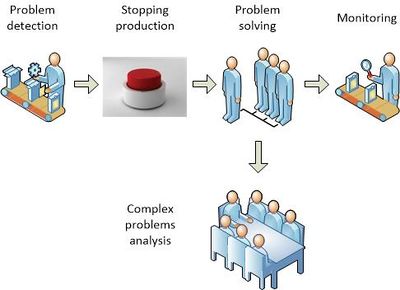Jidoka
| Jidoka |
|---|
| See also |
Jidoka is a solution on production line that empower workers to stop production process immediately in case of any quality problems. After stopping the line, workers and managers have certain time to solve the problem. This limits number of defect products. The first Jidoka implementation was made by Sakichi Toyoda in 1902. He constructed a utility that stopped the loom when the thread was broken. It is regarded as the first part of Toyota production system.
In order to be able to stop the production line, workers need to know the quality of products and have technical possibility to stop the line. In order to provide workers with the information, automatic or manual quality control appliances are installed, which check all or chosen products.
Close to each workplace should be installed a button, which stops whole production line or some part of it (depending on used technology). Usually there is a time limit set by top management, in which the problem must be solved. After that time the production must start. Therefore, this solution is not intended to solving sophisticated problems.
Jidoka is related to Andon - the information system that helps workers to spot the problem immediately, even when they are far from the machines.
Jidoka is one of Lean manufacturing pillars, together with: Konnyaku stone, Poka yoke, Hansei, Andon, Just in time, Heijunka, Kaizen, Genchi genbutsu, Nemawashi.
Autonomation
Autonomation is a feature of machine that allows using Jidoka. It is described as intelligent automation. The autonomation can include:
- automatic problems detection,
- automatic stop,
- automatic fixing of product,
- presenting information about possible causes and countermeasures.
Thanks to automatic detection, workers don't have to stand close to the machine. It allows them to monitor many machines. It is important on modern production line, where workers perform only several operations. In order to achieve such effect, the operation of machines has to be harmonized. The Single minute exchange of die (SMED) method is used for this. Autonomation is important when using Just in time. It's also important part of Lean manufacturing systems.
Sometimes Jidoka and Autonomation terms are used interchangeably.
Requirements of Jidoka
In order to work properly, Jidoka requires:
- appliances that enable workers to stop production
- organizational solutions that help solve problems quickly
- relatively small number of defects, otherwise Jidoka will stop production too often
- machines in good condition
- preferably 5S method
- defects-proof design
- defects-proof technology
Benefits of Jidoka
The main benefits are[1]:
- to avoid the spread of bad practices
- no defective products produced
- to add human judgment to automated equipment
- to minimize poor quality
- to make the process more dependable
- to have problems clearly identified so that Kaizen can be accomplished
- to give the employee responsibility and authority to stop production
- to prevent equipment breakdown
- high-quality products and improvement in productivity.
References
- Basic Toyota Production System Handbook (PDF)
- Baudin M. (2007), Working with Machines: The Nuts and Bolts of Lean Operations with Jidoka, Productivity Press, New York
- Berk E., Toy A.Y. (2009), Quality control chart design under Jidoka, Naval Research Logistics, Vol. 56, Iss. 5
- Damanpour, F. (1998), The impact of culture on management; A comparison of Japanese versus U.S management, Advances in Competitiveness Research
- Womack, J.P., Jones, D.T. and Roos, D. (1990) The Machine that Changed the World: The Triumph of Lean Production, New York, Rawson Macmillan
- Wong, V., Saunders, J. and Doyle, P. (1987) Japanese Marketing Strategies in the United Kingdom, Long Range Planning, vol. 20, no.6, p. 54–63
Author: Slawomir Wawak
